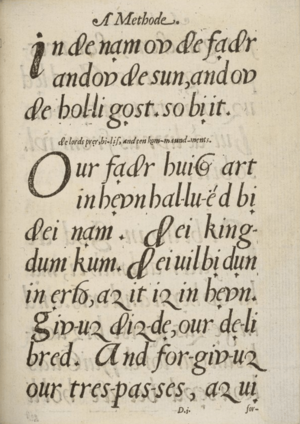John Hart (spelling reformer) facts for kids
John Hart (who died in 1574) was an English teacher and expert in grammar. He is best known for trying to change how English was spelled. His ideas for spelling reform have been called "the first truly sound-based system" for early English. John Hart also worked as an officer of arms, holding the title of Chester Herald from 1566 to 1574.
John Hart's Spelling Ideas
John Hart wrote three main works about grammar and spelling. One was an unpublished book from 1551 called The Opening of the Unreasonable Writing of Our Inglish Toung. He also published a booklet in 1569 named An Orthographie. Finally, he wrote a simple reading guide in 1570 called A Methode or Comfortable Beginning for All Unlearned.
In these writings, Hart complained that the way English was spelled back then was messy and didn't make sense. He wanted a new spelling system based purely on how words sound. His main goal was to have one letter for each sound we make when we speak, and no more.
To do this, he created six new symbols for certain consonant sounds. He also made a system of special marks for vowels. For example, long vowels had a dot under them. A common, short vowel sound (like the 'a' in 'about') was marked with an 'ë'.
Here are some of the symbols John Hart suggested:
Why Hart's Work Is Important
Experts today praise John Hart's work. They say he had a very good understanding of how Early Modern English (the English spoken in his time) sounded. He was also very thorough in trying to make spelling match sounds.
His notes on how vowels were pronounced are especially helpful for people who study the history of the English language. This is because his writings show how English sounded during the Great Vowel Shift. This was a big change that happened to English vowels during Hart's lifetime. For example, he wrote that some words which used to have a long 'ee' sound (like in 'see') but now have an 'eye' sound (like in 'my') were still changing. Some people still said the 'ee' sound, while others were already using a new 'ei' sound.
An Example of Hart's Spelling
Here is a short part from Hart's book An Orthographie. It shows how his spelling system worked. (The special new consonant symbols have been replaced by modern symbols to make it easier to read.)
{{{1}}}


